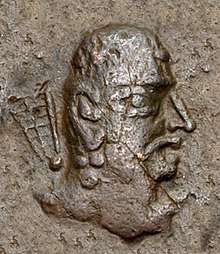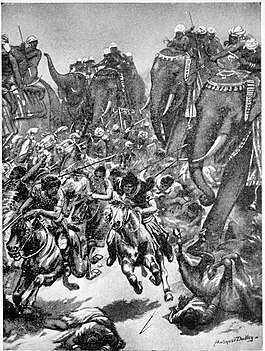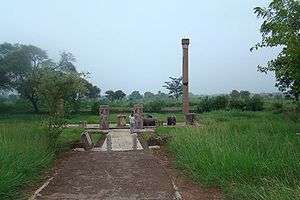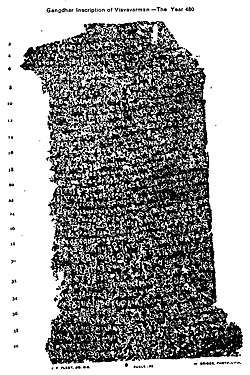Aulikaras
The Aulikaras (Sanskrit: औलीकर) were an ancient Indian clan. Two royal houses belonging to this clan ruled over the present-day western Malwa region of Madhya Pradesh state from c. 350 CE to 550 CE.[4]
Aulikaras | |||||||||||
|---|---|---|---|---|---|---|---|---|---|---|---|
| 4th century–6th century | |||||||||||
| Capital | Mandsaur | ||||||||||
| Common languages | Sanskrit | ||||||||||
| Religion | Shaivism | ||||||||||
| Government | monarchy | ||||||||||
| History | |||||||||||
• Established | 4th century | ||||||||||
• Disestablished | 6th century | ||||||||||
| |||||||||||
| Today part of | India | ||||||||||

Epigraphical discoveries have brought to light two distinct royal houses, who call themselves as the Aulikaras and ruled from Dashapura (present-day Mandsaur). The first royal house, which ruled from Dashapura comprised the following kings in the order of succession: Jayavarma, Simhavarma, Naravarma, Vishvavarma and Bandhuvarma.
The Rīsthal stone slab inscription discovered in 1983 has brought to light another royal house, which comprised the following kings in the order of succession: Drumavardhana, Jayavardhana, Ajitavardhana, Vibhishanavardhana, Rajyavardhana and Prakashadharma, who defeated Toramana. In all probability, Yashodharman also belonged to this house and he was the son and successor of Prakashadharma.[5][6] Yashodharma defeated Mihirakula and freed the Malwa region from the Hunas. The rule of the Aulikaras over Malwa ended with him.[4]
Origin of the Aulikaras
Nothing is mentioned about the origin of the Aulikaras or the Olikaras (as mentioned in the Bihar Kotra inscription of Naravarma) in their inscriptions. Based on the fact that, they used the Malava Samvat in preference to the use of Gupta era in all of their inscriptions in spite of their first royal house being a feudatory of the Guptas, historian D. C. Sircar assumed them as a clan of the Malavas. This clan settled in the Dasheraka region (present-day western Malwa) in the course of their migration from the North-West. His view was supported by K.K. Dasgupta and K.C. Jain.[7]
The first royal house
Earliest information regarding the first royal house is known from two inscriptions of Naravarma, the Mandsaur inscription dated Malava Samvat 461 (404 CE) and the Bihar Kotra inscription dated Malava Samvat 474 (417 CE). The founder of this house is Jayavarma. He was succeeded by his son, Simhavarma, who is mentioned as a Kshitisha (king). His son and successor Naravarma is mentioned as a Parthiva (king) and Maharaja. His epithet was Simhavikrantagami (one who moves with the stride of a lion).
Naravarma was succeeded by his son Vishvavarma, who is mentioned in the Gangadhar Stone Inscription of Viśvavarman dated Malava Samvat 480 (423 CE). The Gangadhara stone inscription records construction of a Matrika temple by his minister Mayurakshaka. Mayurakshaka also constructed a temple dedicated to Vishnu. Vishvavarma was succeeded by his son Bandhuvarma, who is eulogised by poet Vatsabhatti in the Mandsaur stone inscription of the guild of silk-weavers dated Malava Samvat 529 (473 CE). This inscription informs us that he was a feudatory of the Gupta emperor Kumaragupta I. It was during his reign, a temple dedicated to Surya was constructed by the guild of silk-weavers at Dashapura in the Malava Samvat 493 (436 CE).[5] This temple was renovated in 473 CE by the same guild.
The intermediate period
The history of Dashapura remained obscure after Bandhuvarma. The Mandsaur inscription dated Malava Samvat 524 (467 CE), written by Ravila mentions a king of Dashapura named Prabhakara, who defeated the enemies of the Guptas. Dattabhata was the commander of his army, whose donations to the Lokottara Vihara is recorded in this inscription. Soon after Prabhakara, another Aulikara royal house came to power, about which we came to know from the Risthal inscription.[5] The exact relationship between these two royal houses is not certain.
The second royal house
A stone slab inscription discovered in 1983 in Risthal near Sitamau, has brought to light another royal house belonging to the Aulikara family. This inscription dated Malava Samvat 572 (515 CE) is written by poet Vasula, son of Kakka in chaste Sanskrit. The script used is the late Gupta Brahmi paleographically assignable to the 5th-6th centuries. Unlike the earlier royal house, this royal house was never a Gupta feudatory. The Risthal inscription mentions Drumavardhana as the founder of this house. He assumed the title, Senapati. He was succeeded by his son Jayavardhana, who commanded a formidable army. He was succeeded by his son Ajitavardhana. According to the Risthal inscription, he was constantly engaged in performing Soma sacrifices. Ajitavardhana was succeeded by his son Vibhishanavardhana. He was praised in the Risthal inscription for his noble qualities. Vibhishanavardhana's son and successor Rajyavardhana expanded his ancestral kingdom. Rajyavardhana was succeeded by his son Prakashadharma.[5]
Prakashadharma

Prakashadharma was a notable king of this dynasty, who assumed the title, Adhiraja. The Rīsthal inscription gives us information about his achievements. It records the construction of a tank and a Shiva temple at Risthal by Bhagavaddosha, a Rajasthaniya (viceroy) of Prakashadharma. This inscription mentions that Prakashadharma defeated the Huna ruler Toramana, sacked his camp and had taken away the ladies of his harem. The tank constructed at Risthal during his reign was named after his grandfather as Vibhishanasara. He also constructed a temple dedicated to Brahma at Dashapura.[5] During the excavation at Mandsaur in 1978 by a team of Vikram University, Ujjain, led by V.S. Wakankar, his two glass seals inscribed with the legend Shri Prakashadharma were found.[8] In all probabilities he was succeeded by his son Yashodharma Vishnuvarma.[5]
An undated fragmentary Mandsaur inscription provides a name of a suzerain ruler Adityavardhana and his feudatory Maharaja Gauri. Adityavardhana has been recently identified with Prakashadharma by a historian Ashvini Agarwal.[9] The Chhoti Sadri inscription dated Malava Samvat 547 (490 CE) and written by Bhramarasoma, son of Mitrasoma supplies a genealogy of Adityavardhana's feudatory ruler, Maharaja Gauri. The first ruler of this Manavayani kshatriya family was Punyasoma. He was succeeded by his son Rajyavardhana. Rashtravardhana was the son of Rajyavardhana. Rashtravardhana's son and successor was Yashogupta. The last ruler of this family, Gauri was son of Yashogupta. He excavated a tank at Dashapura for the merit of his deceased mother.[4] This inscription also mentions the name of a prince, Gobhata but his relationship with Gauri is not known.[9]
Yashodharma

The most prominent king of this dynasty was Yashodharma Vishnuvardhana. Yashodharma's two identical undated Mandsaur victory pillar inscriptions (found at Sondani, near present-day Mandsaur town) and a stone inscription dated Malava Samvat 589 (532 CE) record the military achievements of him.[10] All of these inscriptions were first published by John Faithfull Fleet in 1886. The undated pillar inscriptions, which were also written by poet Vasula, son of Kakka say that his feet were worshipped by the Huna ruler Mihirakula. These also state that his feudatories from the vicinity of the river Lauhitya (Brahmaputra) in the east, from the Mahendra mountains (Eastern Ghats) in the south, up to the Himalayas in the north and the Paschima Payodhi (Arabian Sea) in the west came to the seat of his empire to pay homage.[5][2] he assumed the titles, Rajadhiraja and Parameshvara.[5] Yashodharma's dated inscription informs us that in 532 CE, Nirdosha, his Rajasthaniya was governing the area between the Vindhyas and the Pariyatras (Aravalis) and his headquarters was Dashapura. Probably the rule of the Aulikaras ended with Yashodhrma[4]
In Line 5 of the Mandsaur pillar inscription, Yashodharman is said to have vanquished his enemies and to now control the territory from the neighbourhood of the (river) Lauhitya (Brahmaputra River) to the "Western Ocean" (Western Indian Ocean), and from the Himalayas to mountain Mahendra.[11][12]
Yashodharman thus conquered vast territories from the Hunas and the Guptas,[13] although his short-lived empire would ultimately disintegrate between 530-540 CE.[12]
Successors of the Aulikaras
A fragmentary undated inscription of a hitherto unknown ruler Kumaravarma was found by Girija Shankar Runwal during Mandsaur excavation by the team of Vikram University, Ujjain in 1979 from the foundations of a building. This inscription, paleographically assignable to the late 5th-early 6th centuries, records a dynasty comprising four successive rulers: Yajnadeva, Virasoma, his son Bhaskaravarma and his son Kumaravarma.[14] Wakankar claimed them as the Aulikaras[8] and V.V. Mirashi claimed this dynasty a separate one, which defeated and succeeded the Aulikaras. But none of these theories received support from other historians. Most probably the Kalachuris succeeded the Aulikaras, as the Kalchuri kings Krishnaraja and his son Shankaragana are found ruling over the same region immediately after the Aulikaras.[14] The Maitrakas too may have been successors of the Aulikaras.[15]
Aulikara administration
Only three offices of the Aulikaras are known from their epigraphical records: the Senapati (commander-in-chief), the Amatyas (ministers) and the Rajasthaniya (viceroy). The exact nature of the office of the Rajasthaniya, which is mentioned in several inscriptions is not clear from them. George Buhlar rendered Rajasthaniya as the viceroy, and his view is mostly accepted. It seems that the office of the Rajasthaniya of the Aulikaras became hereditary in the Naigama family since the days of Shashthidatta. Shashthidatta's son Varaha is identified with Varahadasa of the Chittaurgarh fragmentary inscription of his grandson by a historian D.C. Sircar. Varaha's son Ravikirti was an amatya under Rajyavardhana. He had three sons by his wife Bhanugutpa: Bhagavaddosha, Abhayadatta and Doshakumbha. Bhagavaddosha was a Rajasthaniya under Prakashadharma. His younger brother Abhayadatta was appointed a Rajasthaniya after him[16] The Chiitaurgarh fragmentary inscription mentions Abhayadatta as a Rajasthaniya of Dashapura and Madhyama.[4] The Mandsaur inscription dated Malava Samvat 589 describes Abhayadatta as the Rajasthaniya' between the Vindhyas and the Pariyatras. His nephew and son of Doshakumbha, Nirdosha succeeded him as the Rajasthaniya of the same region. Nirodsha's elder brother Dharmadosha was also a high-ranking official under the Aulikaras, but his exact designation is not known.[16]
Art and architecture

The most significant monuments which definitely belong to the Aulikara period are two freestanding victory pillars of Yashodharma Vishnuvardhana bearing his iinscriptions. These almost identical pillars, situated at Sondani, a suburb to the southeast Mandsaur, are made of sandstone. The height of the entire column is 44 ft 5 in. Its square base is 4 ft 5 in high and 3 ft 4 in wide. The bell-shaped capital is 5 ft 2 in high. Its shaft is sixteen faced round. Most probably there was a crowning statue, which has not been found.[17]
Notes
- Corpus Inscriptionum Indicarum Vol 3 p.145
- Salomon, Richard (1989). "New Inscriptional Evidence For The History Of The Aulikaras of Mandasor". Indo-Iranian Journal. 32 (1): 11. ISSN 0019-7246. JSTOR 24654606.
- Vowels according to Prinsep
- Jain, Kailash Chand (1972). Malwa Through the Ages. Delhi: Motilal Banarsidass. pp. 250–9. ISBN 978-81-208-0824-9.
- Agarwal, Ashvini (1989). Rise and Fall of the Imperial Guptas, Delhi:Motilal Banarsidass, ISBN 81-208-0592-5, pp.250-6
- Salomon, Richard (1989). "New Inscriptional Evidence For The History Of The Aulikaras of Mandasor". Indo-Iranian Journal. 32 (1): 12. ISSN 0019-7246. JSTOR 24654606.
- Ojha, N.K. (2001). The Aulikaras of Central India: History and Inscriptions, Chandigarh: Arun Publishing House, ISBN 81-85212-78-3, pp.25-7
- Wakankar, V.S. (1981) Aulikara Vamsha ke Itihas par Naya Prakash (in Hindi) in M.D. Khare ed. Malwa through the Ages, Bhopal: Directorate of Archaeology & Museums, Government of Madhya Pradesh, pp,278-9
- Ojha, N.K. (2001). The Aulikaras of Central India: History and Inscriptions, Chandigarh: Arun Publishing House, ISBN 81-85212-78-3, pp.37-41
- Ojha, N.K. (2001). The Aulikaras of Central India: History and Inscriptions, Chandigarh: Arun Publishing House, ISBN 81-85212-78-3, pp.19-20
- Corpus Inscriptionum Indicarum Vol 3 p.145
- Foreign Influence on Ancient India by Krishna Chandra Sagar p.216
- Tribal Culture, Faith, History And Literature, Narayan Singh Rao, Mittal Publications, 2006 p.18
- Ojha, N.K. (2001). The Aulikaras of Central India: History and Inscriptions, Chandigarh: Arun Publishing House, ISBN 81-85212-78-3, pp.106-8
- Salomon, Richard (1989). "New Inscriptional Evidence For The History Of The Aulikaras of Mandasor". Indo-Iranian Journal. 32 (1): 30. ISSN 0019-7246. JSTOR 24654606.
- Ojha, N.K. (2001). The Aulikaras of Central India: History and Inscriptions, Chandigarh: Arun Publishing House, ISBN 81-85212-78-3, pp.60-4
- Ojha, N.K. (2001). The Aulikaras of Central India: History and Inscriptions, Chandigarh: Arun Publishing House, ISBN 81-85212-78-3, pp.99-100

.svg.png)
